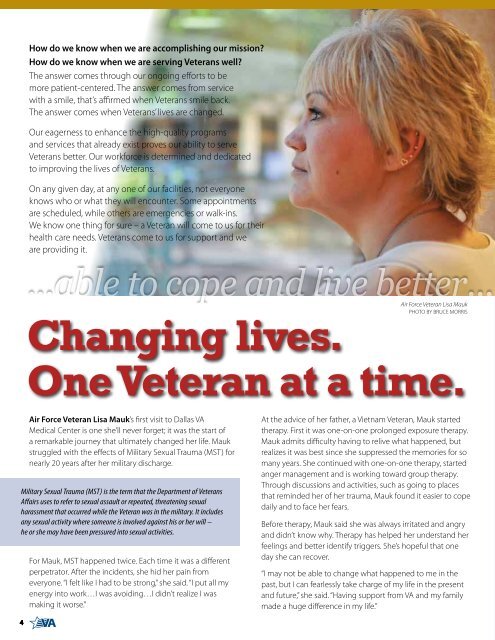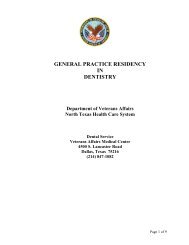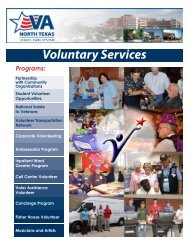Pulse - VA North Texas Health Care System
Pulse - VA North Texas Health Care System
Pulse - VA North Texas Health Care System
You also want an ePaper? Increase the reach of your titles
YUMPU automatically turns print PDFs into web optimized ePapers that Google loves.
4<br />
How do we know when we are accomplishing our mission?<br />
How do we know when we are serving Veterans well?<br />
The answer comes through our ongoing efforts to be<br />
more patient-centered. The answer comes from service<br />
with a smile, that’s affirmed when Veterans smile back.<br />
The answer comes when Veterans’ lives are changed.<br />
Our eagerness to enhance the high-quality programs<br />
and services that already exist proves our ability to serve<br />
Veterans better. Our workforce is determined and dedicated<br />
to improving the lives of Veterans.<br />
On any given day, at any one of our facilities, not everyone<br />
knows who or what they will encounter. Some appointments<br />
are scheduled, while others are emergencies or walk-ins.<br />
We know one thing for sure – a Veteran will come to us for their<br />
health care needs. Veterans come to us for support and we<br />
are providing it.<br />
Changing lives.<br />
One Veteran at a time.<br />
Air Force Veteran Lisa Mauk’s first visit to Dallas <strong>VA</strong><br />
Medical Center is one she’ll never forget; it was the start of<br />
a remarkable journey that ultimately changed her life. Mauk<br />
struggled with the effects of Military Sexual Trauma (MST) for<br />
nearly 20 years after her military discharge.<br />
Military Sexual Trauma (MST) is the term that the Department of Veterans<br />
Affairs uses to refer to sexual assault or repeated, threatening sexual<br />
harassment that occurred while the Veteran was in the military. It includes<br />
any sexual activity where someone is involved against his or her will –<br />
he or she may have been pressured into sexual activities.<br />
For Mauk, MST happened twice. Each time it was a different<br />
perpetrator. After the incidents, she hid her pain from<br />
everyone. “I felt like I had to be strong,” she said. “I put all my<br />
energy into work…I was avoiding…I didn’t realize I was<br />
making it worse.”<br />
Air Force Veteran Lisa Mauk<br />
PHOTO BY BRUCE MORRIS<br />
At the advice of her father, a Vietnam Veteran, Mauk started<br />
therapy. First it was one-on-one prolonged exposure therapy.<br />
Mauk admits difficulty having to relive what happened, but<br />
realizes it was best since she suppressed the memories for so<br />
many years. She continued with one-on-one therapy, started<br />
anger management and is working toward group therapy.<br />
Through discussions and activities, such as going to places<br />
that reminded her of her trauma, Mauk found it easier to cope<br />
daily and to face her fears.<br />
Before therapy, Mauk said she was always irritated and angry<br />
and didn’t know why. Therapy has helped her understand her<br />
feelings and better identify triggers. She’s hopeful that one<br />
day she can recover.<br />
“I may not be able to change what happened to me in the<br />
past, but I can fearlessly take charge of my life in the present<br />
and future,” she said. “Having support from <strong>VA</strong> and my family<br />
made a huge difference in my life.”<br />
One year ago, Navy Veteran Kenneth Ward was visiting a<br />
friend. He stepped out on the porch to leave and woke up<br />
paralyzed and blind. He had slipped off the porch, broke his<br />
neck and crushed his spine. The next few hours were crucial<br />
for Ward. He underwent surgery to repair his neck and spine<br />
and could see again once the swelling on his brain was<br />
reduced. But Ward was still paralyzed.<br />
Days later, he arrived at The Spinal Cord Injury Center at<br />
Dallas <strong>VA</strong> Medical Center to begin rehabilitation. He knew<br />
he was in for the fight of his life, but remained optimistic the<br />
whole time. Ward gives credit to the providers who helped<br />
him, but said he never would have made it without faith.<br />
While he was being fitted for a wheelchair, he told everyone<br />
he wouldn’t need it long.<br />
“I knew I would walk again,” Ward said. “I knew if I wanted to<br />
walk again I not only had to do therapy, but I had to have<br />
faith as well.”<br />
After the first two weeks in<br />
rehabilitation therapy,<br />
Ward began having minor<br />
movement in his right<br />
hand, then his left. A month<br />
later, he could lift his<br />
legs from the wheelchair<br />
footrest. Before long, he<br />
was standing and then<br />
walking with support.<br />
Providers surprised Ward<br />
and told him he was ready<br />
for the treadmill. After a few<br />
weeks on the treadmill, he<br />
received another surprise<br />
– the therapy pool. “Great!”<br />
he thought. “If I can walk in<br />
water, then I’m on my way.” Shortly after pool therapy, Ward<br />
gave up his wheelchair, used a walker for a while and then a<br />
cane. Today, he walks completely unassisted.<br />
How was he progressing so fast? Ward was using concepts<br />
he learned in therapy while he was away from therapy.<br />
In his hospital room he would exercise with his roommate.<br />
When he was released to go home, he would exercise<br />
there. Ward continues therapy and often encourages other<br />
Veterans with spinal cord injuries.<br />
“All of our injuries are different, but we all have something<br />
in common…life,” he said. “It’s something I’ll never take for<br />
granted, and I thank <strong>VA</strong> for giving it back to me.”<br />
...can walk again...<br />
...maintaining a<br />
healthy weight...<br />
For years growing up I was always taught to clean my plate,”<br />
said Army Veteran Daniel Fisher. “It became a habit that stuck<br />
with me well into adulthood.” Fisher said before he knew it, he<br />
weighed 260 pounds and had constant pain in his rib cage<br />
and back. He said it was becoming more and more difficult to<br />
breathe and walk. One day he decided to make a change. He<br />
talked to his primary care physician about his concerns. His<br />
doctor referred him to a weight management program at Dallas<br />
<strong>VA</strong> Medical Center.<br />
MOVE! is a weight management program designed by the Veterans <strong>Health</strong><br />
Administration National Center for <strong>Health</strong> Promotion and Disease Prevention,<br />
a part of the Office of Patient <strong>Care</strong> Services, to help Veterans lose weight, keep<br />
it off and improve their health.<br />
“On the first day of class, I<br />
knew I was in the right place,”<br />
Fisher said. “The teacher was<br />
motivated, other Veterans<br />
were motivated and so was I.”<br />
Fisher learned to count<br />
calories by using a daily log.<br />
He began making menus<br />
and learned to eat right. He<br />
gave up fast food, cut down<br />
on eating fats, breads and<br />
condiments. To satisfy his<br />
sweet tooth, he swapped<br />
desserts for fruits. Before<br />
joining MOVE!, Fisher said<br />
he was eating for taste and<br />
wouldn’t stop even when he<br />
was full. He went from eating<br />
8000-9000 calories a day to eating 1800 calories a day. “It was<br />
very challenging to eat fewer calories in more meals, but I did<br />
it with much support,” he said. At the end of the first six weeks,<br />
Fisher surpassed the goal of losing 5 percent of his total body<br />
weight – he lost 12 percent! Week after week, he continued<br />
dropping at least four pounds each week until he lost a total of<br />
85 pounds.<br />
“I have more energy and feel more alive and I never want to<br />
cross that bridge again,” Fisher said. “I appreciate the support I<br />
received from <strong>VA</strong> that changed my life.”<br />
We stand behind our motto of “Changing lives. One Veteran<br />
at a time.” Veterans can count on <strong>VA</strong> <strong>North</strong> <strong>Texas</strong> <strong>Health</strong> <strong>Care</strong><br />
<strong>System</strong> for their health care needs and beyond.<br />
PULSE | AUGUST 2013 5





